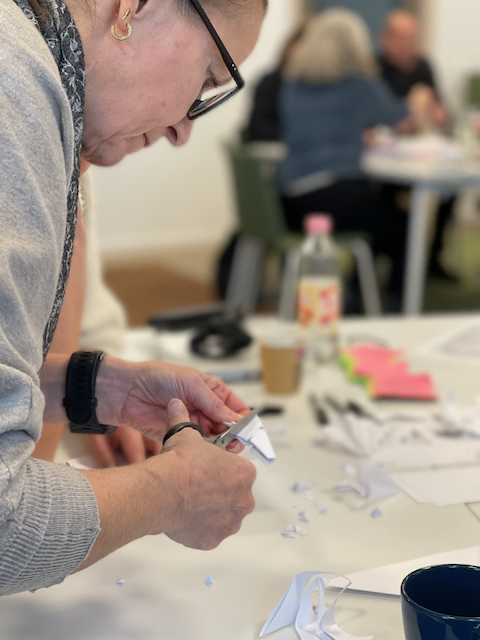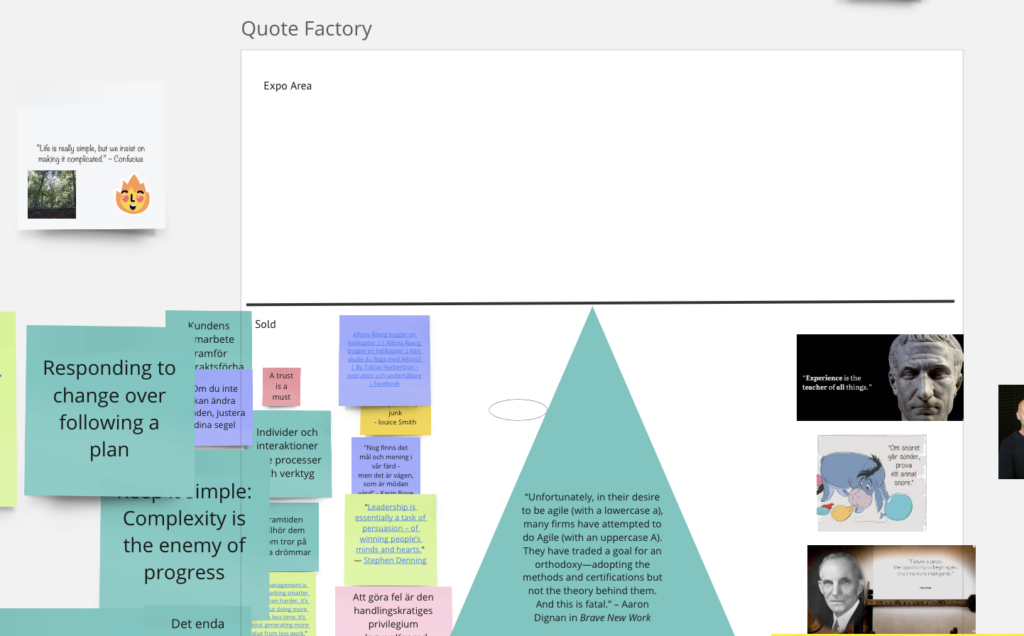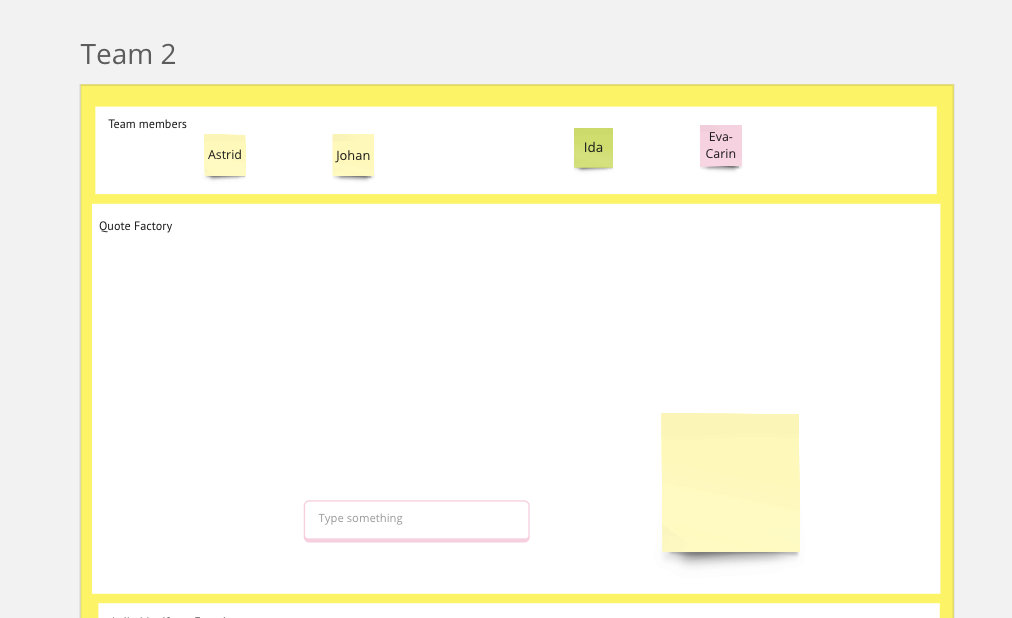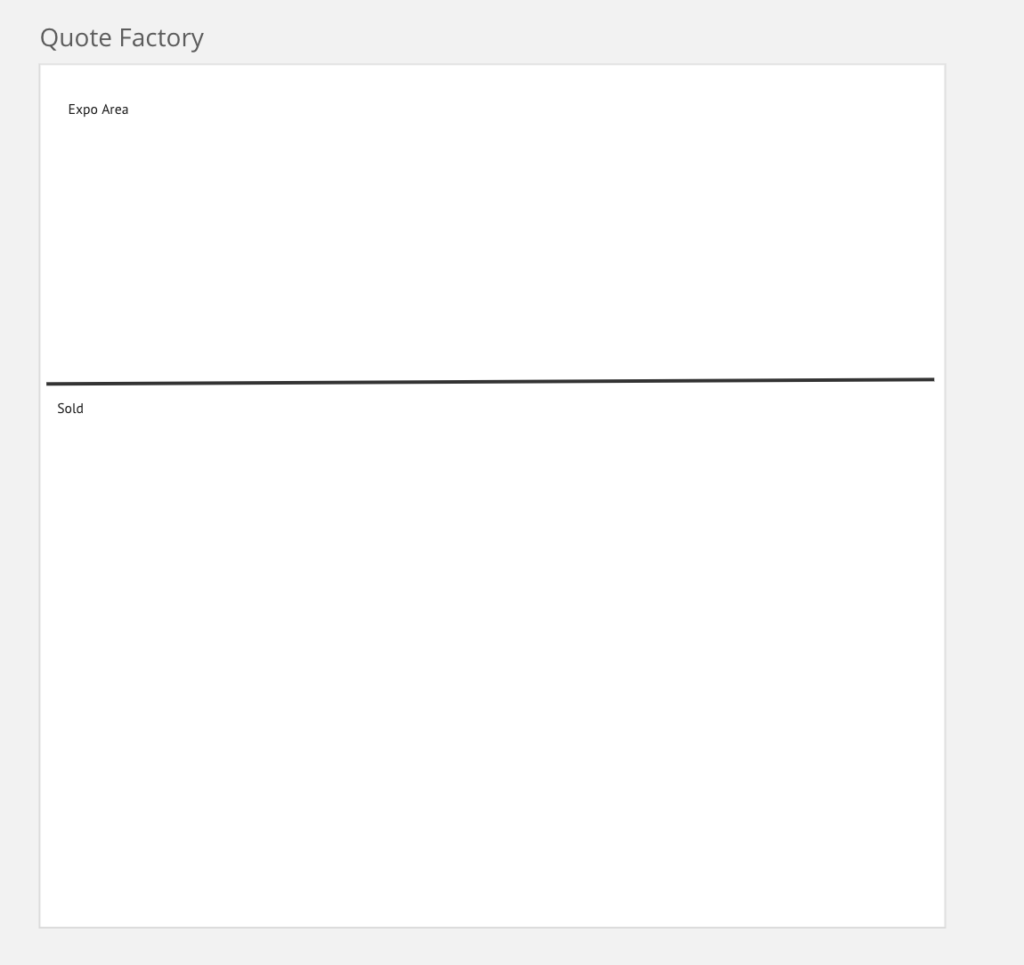Even though the trend right now is that more and more return to the classrooms for in-person training, remote training sessions are for sure not gone. One challenge in remote trainings are energizing and thought provoking exercises, where participants can get a feel for theoretical concepts.
Crisp is fairly well known for its abundance of fun, engaging and to-the-point exercises. Lately, I have combined the in-person exercise snow flakes, with the remote training exercise quote factory, to create an even more engaging exercise for remote trainings.
In this blog, I will explain how I have merged two popular training exercises, Snow Flakes and Quote Factory, to create a dynamic and immersive learning experience.
Snow Flakes
(original description: https://tastycupcakes.org/2012/05/lean-startup-snowflakes/)
The Snow Flakes exercise aims to underscore the importance of customer interaction in value creation. It is that simple. And every time we run the exercise, most teams fail.
Teams engage in short, iterative cycles of crafting and selling paper snowflakes, aiming to decipher customer preferences through rapid feedback loops.
The teams buy scissors and papers and in short 3 minute iterations, they cut and sell paper snowflakes. The thing is, of course, that the teams don’t really know what the buyer wants, or what they are to be used for. So they need to install fast feedback loops in order to discover what works and what doesn’t. Teams get different amounts of money paid for the snowflakes, depending on their quality and usability. This is shown by the facilitator by having buckets of snowflakes on the floor, showing the vendor that, “look, your snowflake is round, but not especially intricate, so it is worth €1”.
The set-up requires a fair amount of props. Scissors and paper to cut the snow flakes, a description on how to cut, and money, so that the teams get into the situation of how much material they should buy (as inventory is not calculated to success, it is waste).
This exercise can be tailored in order to focus on different learning objectives. But the main point is to focus on customer value and that you need fast feedback in order to know what to build.
Quote Factory
(original source Jurgen Appelo, Shift Up training)
The Quote Factory is similar to the Snow Flake exercise in the sense that the main point is fast feedback from real customers in order to create value. But as this exercise is designed for a remote setting, it is not as intricate in the details with props and such. It is fairly straight forward and quick.
The idea is that the teams are to create and sell inspirational quotes to a buyer, much like the snowflakes exercise. And also in this exercise, the teams need to discover what the buyer wants to do with all these quotes (they should concern “agile”, have a credible source, be nice to the eye with pictures, fonts, colors etc).
Why Merge?
What Quote Factory exercise is missing is the iterations/sprints and the money aspects, that different quotes are worth different amounts. So what I felt was that the exercise was a bit thin, it was missing a couple of learnings that I wanted to add in, which was
- Continuous Improvement (enabled by the iterations)
- Different price depending on quality and usability (enabled by interacting with buyer and learn what the buyer needs)
The New Exercise
Summary
In a remote setting, teams produce and present inspirational quotes to a buyer, simulating a real-world market scenario.
The learning objectives of the exercise is that teams need to talk to customers/users to discover what they actually need, and that working with continuous improvement to both their way of work and their product is essential.
Timing
In total 45-60 minutes.
Allow 10 minutes for explaining the exercise.
For the iterations, allow a starting 3 minutes for initial planning. Then you go into the standard cycle of;
- Work, expo and sell for 3 minutes
- Retrospective for 3 minutes
Run 4-5 iterations.
Allow at least 10 minutes for debrief.
Materials
You need a digital whiteboard of some sort with work areas for each team and a timer, and you need video conferencing tool with possibility to do break out rooms.
I usually work with Miro or Mural, and Zoom. Here’s a picture showing a basic layout of a team’s work area;
Setup
For each team, create;
- A work area in your digital whiteboard
- A break out room in your video conferencing tool
- Have a timer for three (3) minutes
Also in your digital whiteboard, create an expo area, where teams showcase their quotes, and a are where you place the quotes teams have sold. See picture below for simple example.
Facilitation Guide
Divide the participants into teams, preferably 3-4 people. 2 works, but more than 5 is too many.
Explain the exercise to the teams:
“You are now teams in a company that creates whatever the market wants. I am your product manager. Right now, inspirational quotes are the latest, and we see a possibility in that market. Your job is to create inspirational quotes, and I will buy them from you.
Each team has a work area in Miro/Mural/Digital whiteboard of your choice. When you want to sell a quote, you move it to the expo area, and get in touch with me, your product manager. I’ll be in the main room, you work in your break out room.
You will work in three minute iterations, and after that you will get a three minute retrospective in which you inspect and adapt.”
If there are questions about the quotes now, answer a few. But make excuses that you need to get them off working, so that not everything is spilled in the beginning.
Start them off with a three minute planning session. When time is up, summon all back to main room. This to have all participants learn how to move between main room and their break out rooms.
Then start the “real” iterations. Depending on how it goes, you might want to summon all back to main room after first iteration, just so they have gotten the hang of when to work and when to do a retrospective.
Your “company” is selling these quotes to agile people who want to post them on social media, as a service. The quotes need to be;
- About agile
- Have a reference, which is a well known agilist
- Be unique
- Be a picture, illustration, nice fonts, etc, so something that stands out
- Colorful
- Etc
You can add your own “requirements” as you like.
When teams come to you to sell quotes, buy them if you don’t have anything similar. But once you’ve got an inventory of some 4-5 similar quotes (i.e. look and feel), then stop buying those. That should drive the team to ask some questions. If they do, answer to the next level. For example, if you get simple quotes without a reference, then say that you need a reference at least. So add “requirements” as they go.
Run 4-5 iterations depending on how much time you have.
Debrief
The learnings that we want to give them are;
- Talk to the customer.
- How come some teams “earned” more than others?
- What happens if just one from the team (a.k.a Product Owner) talks to the Product Manager. What gets lost? Interpretations along the way
- The team need to get out from the office and talk to real users to understand user needs
- Continuous improvement
- What is it that enables the learning in the team?
- The retrospectives.
- Ask the teams what would happen if we removed retrospectives and instead you had double time working? Would you have created better quotes?
Or if you had got all the planning time up front? Then work. Better, worse or the same result?- When working with unknowns we need to experiment and discover what “right” looks like. Without retrospectives or similar, teams don’t stop and think. We need the pauses to create learnings. Then go again, based on those new learnings
- What is it that enables the learning in the team?
- Communication is key
- Were all in the team knowing what was happening? If not, why?
- Was it important with specific roles?
- No is the answer here, as roles often limits people instead of freeing up creativity
Summing up
The fusion of Snow Flakes and Quote Factory creates a robust remote training exercise, emphasizing customer-centricity and iterative refinement, which is key to create the learnings needed, which is central to becoming agile.
I hope this write-up was useful to you. I’d be glad to get your comments, ideas and suggestions on your favorite remote exercises.







